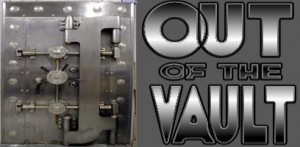
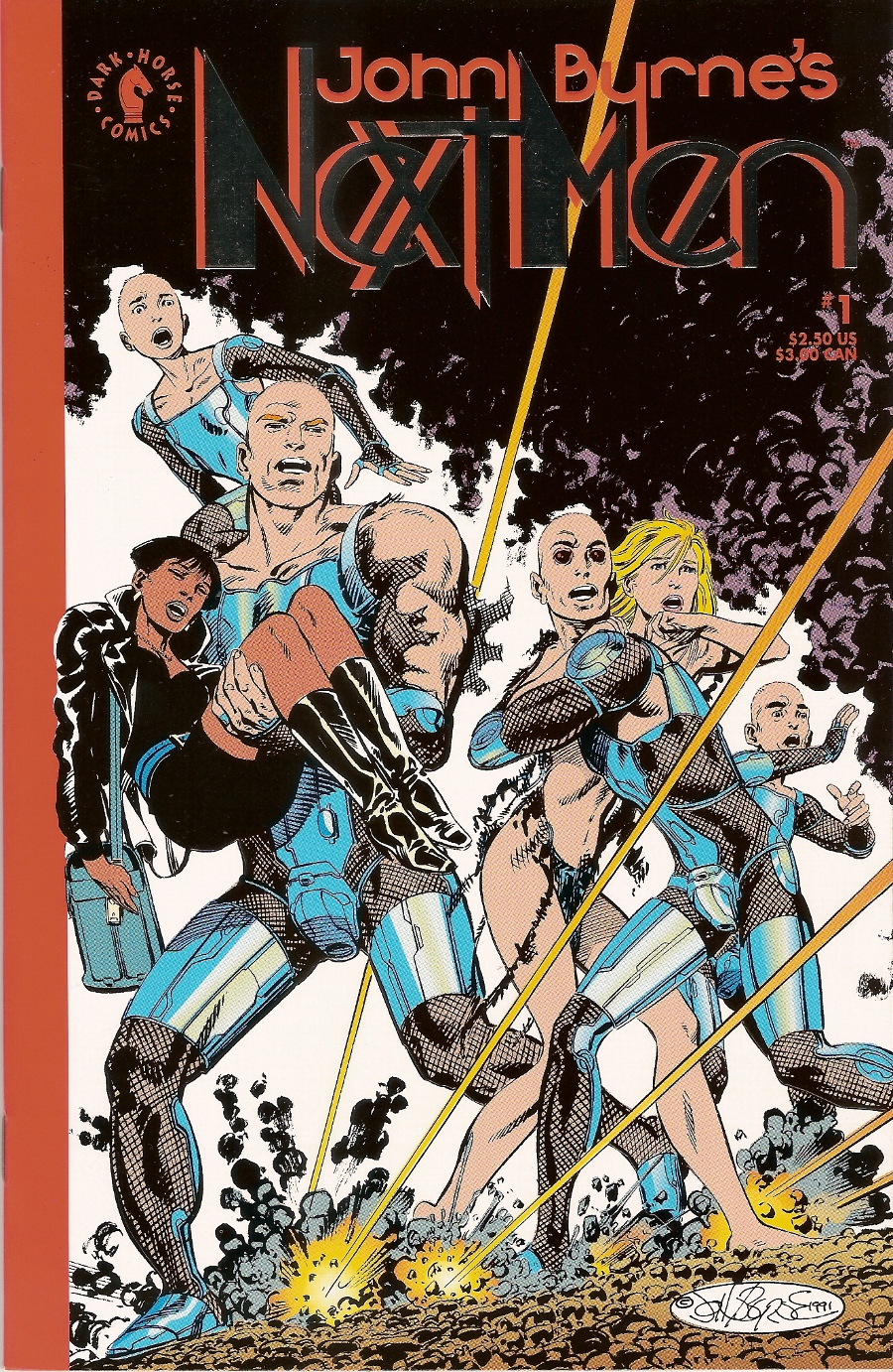 Hard as it may seem to believe now, the X-Men weren’t always the gargantuan fan favorites they are now. They hung around on the fringes of the Marvel universe for years until Chris Claremont and the late Dave Cockrum teamed up for a stellar 13-issue run that spiked the group’s popularity, culminating in a massive battle between the X-Men and the alien Shi’ar Imperial Guard (a thinly disguised Legion of Super Heroes, the feature Cockrum drew in his days at DC).
Hard as it may seem to believe now, the X-Men weren’t always the gargantuan fan favorites they are now. They hung around on the fringes of the Marvel universe for years until Chris Claremont and the late Dave Cockrum teamed up for a stellar 13-issue run that spiked the group’s popularity, culminating in a massive battle between the X-Men and the alien Shi’ar Imperial Guard (a thinly disguised Legion of Super Heroes, the feature Cockrum drew in his days at DC).
When the two-issue battle concluded, though, there had been a change in artists, which I eyed dubiously. No one but Cockrum could have drawn the previous issue; surely no one but Cockrum could rightfully end the saga.
By the end of the issue, though, I was a believer in John Byrne. Together with Claremont and inker Terry Austin, he took the book to new heights of popularity, and in the process changed not only the ecology of Marvel but arguably the course of the entire comics industry.
And after he left X-Men to write and draw Fantastic Four, he did it again. His run on the book was not only incredibly popular, but the way he redefined Sue Storm as a total badass showed his writing chops as well. And he did it again with Superman, not only renewing the hero’s popularity, but redefining Lex Luthor as a cold-hearted corporate head so convincingly that he became the template for the movie versions of the Green Goblin, the Kingpin, and Doctor Doom.
It was probably inevitable, then, that one of the most popular artists in comics would then leave to create his own property, out from under the work-for-hire umbrella of Marvel and DC. That book was Next Men, or more properly, John Byrne’s Next Men. Like Frank Miller’s Sin City, Next Men debuted first in the anthology title Dark Horse Presents…, then moved to its own book after (I think) six chapters.
The story, briefly: a group of young people with incredible powers live in an idyllic forest known as The Greenery, which they occasionally have to defend from invaders. No one ever dies in The Greenery; instead, they fade, turning transparent and then disappearing forever. Bethany, Jasmine, Danny, Jack and Nathan are the last five survivors, when they all suddenly fade in quick succession…
To wake up in a laboratory in strange tubes, which have been feeding them a virtual reality simulation. They were the products of a government experiment in genetics to create a super-army, but heroic female agent Tony Murcheson penetrates the secret base and busts them out of confinement. They soon learn that the real world doesn’t exactly work the same as The Greenery.
Danny, the speedster, eventually builds up calluses on his feet and huge leg muscles. Nathan can perceive the entire electromagnetic spectrum. Jazz is extraordinarily agile. Jack is super-strong. And Bethany is absolutely impervious to damage. Even her hair, which brings some grief to a gang of bikers who attempt to rape her.
The escapees run afoul of small town cops and the unfortunate bikers above and end up being blamed for the destruction of the secret “agricultural station” (which is actually carried out by Senator Aldus Hilltop, the series’s master villain).
Issue seven introduced a new chapter of the saga, along with a new logo and a change in format. There was now a back-up feature, M4, which ran in the back half as a flip book for four issues before switching to a normal back-up feature. The Next Men had been recruited as covert government operatives and for their first mission were sent to confront a Russian mutate who could create solid illusions with his mind.
And no, in case you’re wondering, I didn’t base Davy Lopez from Hero Go Home! on this character. I came up with the concept years before Byrne did this storyline. Not saying Davy wasn’t influenced by other works–the movie Forbidden Planet, for instance or the Shaper of Worlds from the Batman vs. the Incredible Hulk crossover–just not so much this one.
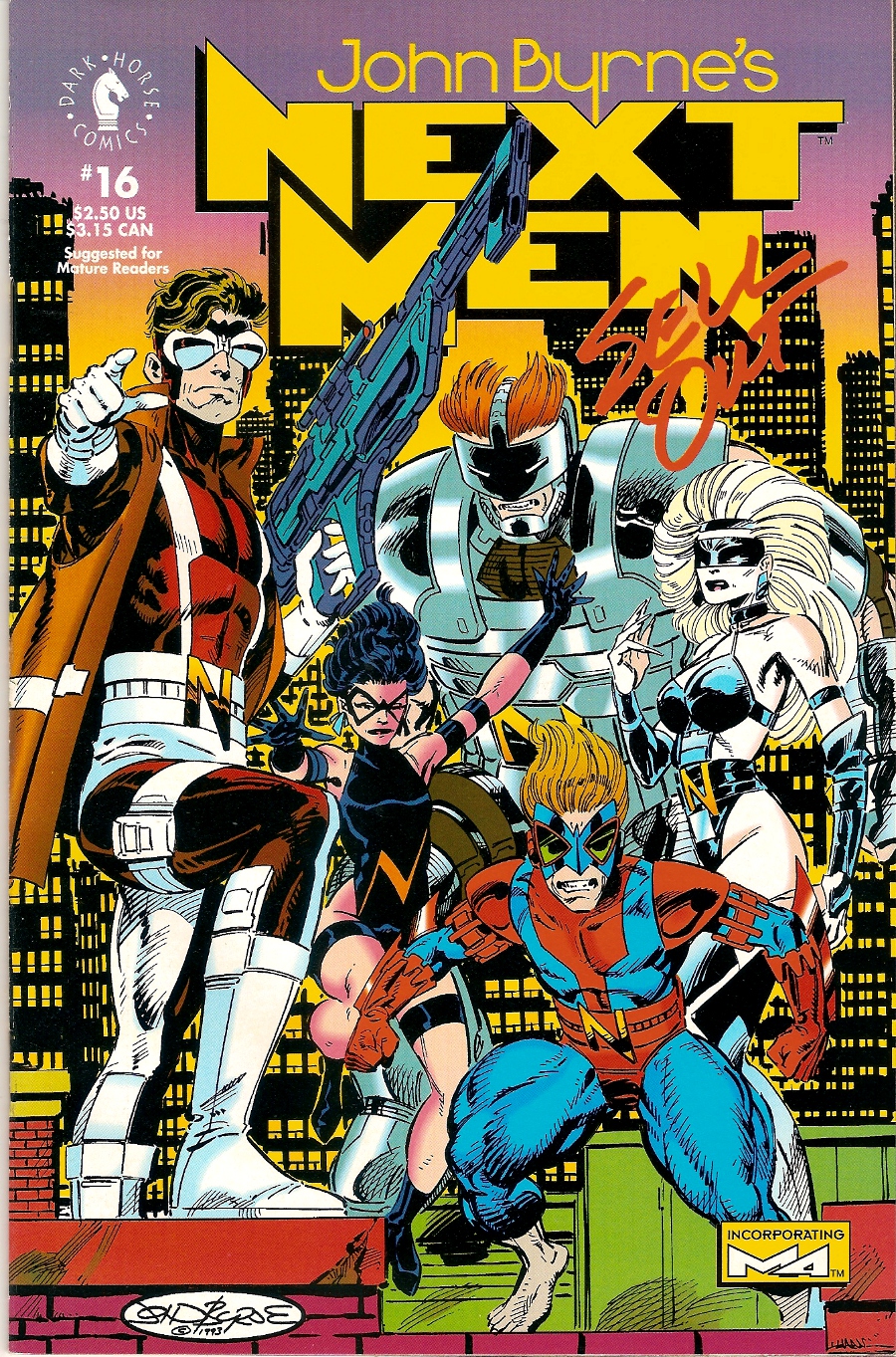 Anyway, in the meantime, Danny (who was not sent to Russia with the rest of the team because of his youth) instead went on another adventure which ended up with him in New York, visiting the offices of a comic book company. Which led into the next chapter in the group’s lives, as they all ended up inspiring a comic book about their characters, which led to their going public, which led to their arrest on murder charges by the small-town sheriff from the early issues. Â At the end of issue 18, they are found guilty on all charges.
Anyway, in the meantime, Danny (who was not sent to Russia with the rest of the team because of his youth) instead went on another adventure which ended up with him in New York, visiting the offices of a comic book company. Which led into the next chapter in the group’s lives, as they all ended up inspiring a comic book about their characters, which led to their going public, which led to their arrest on murder charges by the small-town sheriff from the early issues. Â At the end of issue 18, they are found guilty on all charges.
One other interesting thing about that third six issue arc was that, in the letter column of #16, cover-dated July 1993, John Byrne mentioned that Rob Liefeld of Image Comics had approached him about a Next Men/Youngblood crossover. Byrne’s reply? “I do not want to see the book mixed in with anyone else’s universe. Never. Ever. Uh uh. No way. Won’t happen…”
But then in issue 21, cover-dated December 1993, a familiar-looking character made an appearance in pages guest-drawn by Mike Mignola.
Turns out, this isn’t actually Hellboy, but the creation of a mutate and comic-book fan who can create solid illusions with the power of her mind (what, again?) So you could argue that this isn’t technically a “crossover,” but seriously: they put Hellboy on the cover to cross-promote. It’s a crossover.
So what happened in the meantime? Legend, a special all-star imprint of Dark Horse created by Byrne and Frank Miller, with other creators including Mignola, Art Adams, and Paul Chadwick also becoming members. So over the next two story arcs, “Faith” and “Power,” the characters of the Next Men universe encountered not only Hellboy, but Paul Chadwick’s Concrete. And in one issue, Art Adams’s Monkeyman and O’Brien squared off against Cutter and Skywise from Elfquest.
That’s right, the illusions were even fighting each other when no one else was around, with no point except to publicize somebody else’s books.
The series culminated in a final four issue arc, “Lies,” which pitted the Next Men minus Jack (who had converted to Christianity and quit the group to join a blind priest shepherding a group of homeless orphans in the sewers–really) against their nemesis Hilltop, now President of the United States and a mutate himself, thanks to a one-night stand with Jazz (yes, superpowers in Next Men were a sexually transmitted disease). There were double-crosses and time travel hijinks, ending with the White House being blown up, the Next Men lost somewhere in the timestream, Hilltop nearly dead but having now become Sathanas (the disfigured mutant time-traveler who advised Hilltop in his rise to power from 1955 until the present–yeah, it’s a paradox), and M4, the  shape-shifting android from the back-up feature, assuming Hilltop’s identity and taking over his presidency. Wow.
In the 30th and final issue, Byrne announced that Next Men would be going on hiatus while he went back to Marvel and DC to make some money. But he did tease a pic of Jazz, Nathan and Danny fleeing a dinosaur on the inside back cover.
But they didn’t come back. At least, not for fifteen years. Apparently, Byrne started a new Next Men arc just last year. I can’t afford comics anymore, though, so I don’t know if it’s any good or not. The original series was flawed but intriguing enough that I hung on for all 30 issues, so if my finances ever turn right side up again, the new Next Men books might be worth checking out.

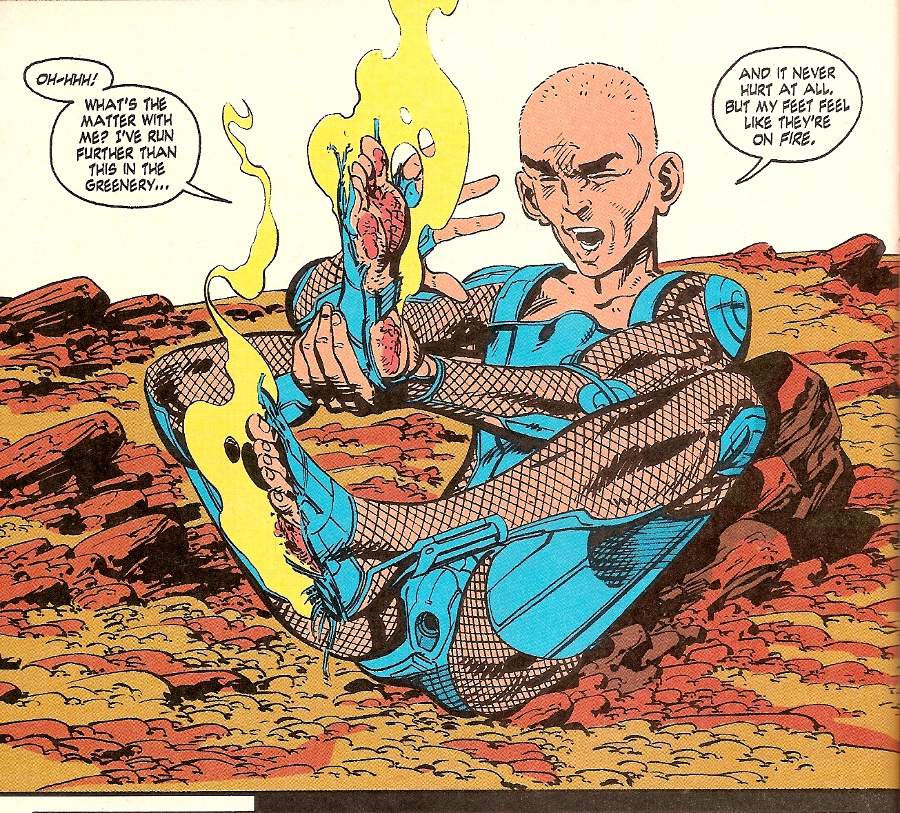
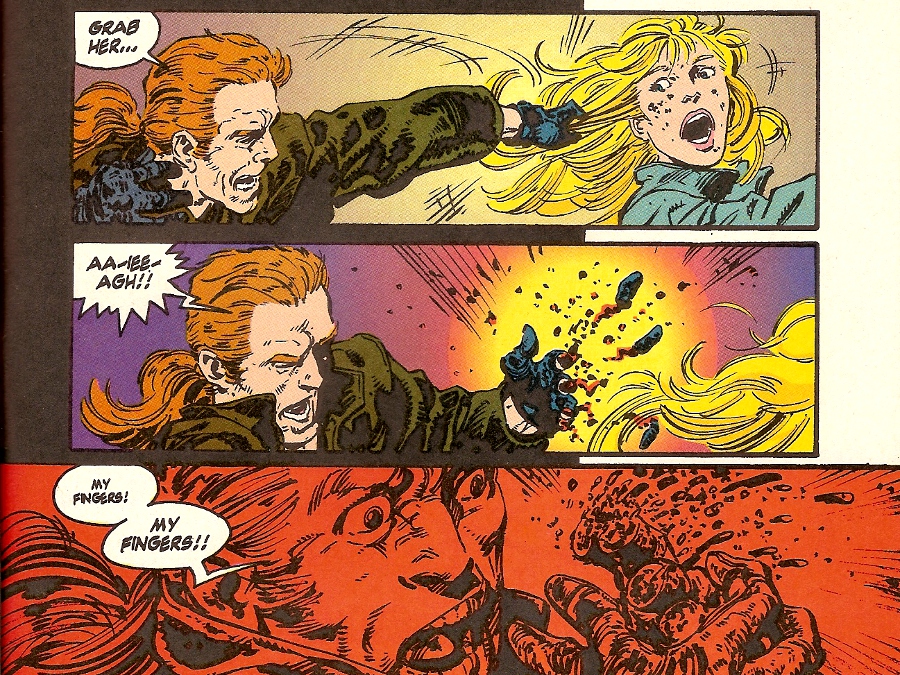

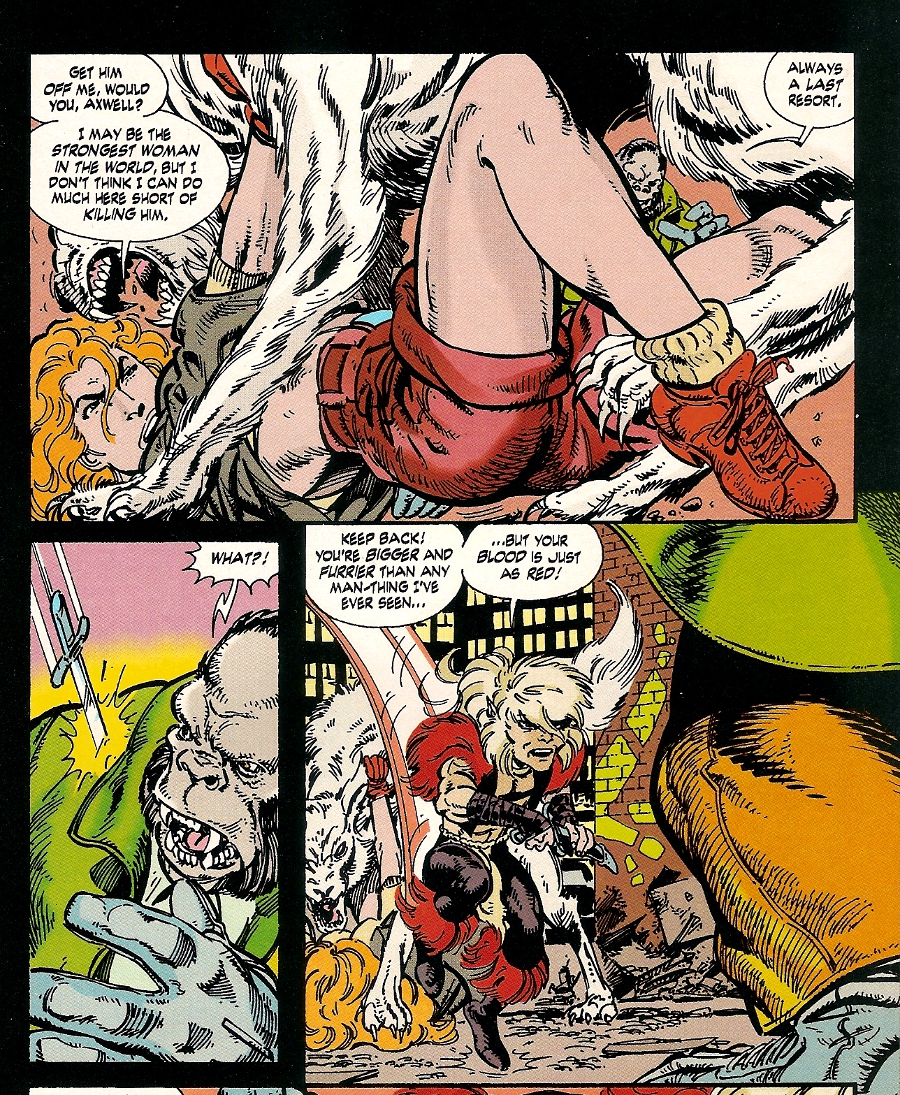



Did you read the new arc? It’s actually… interesting and it more than ties up loose ends. It nails them shut. PS – I am glad he did not team up with Liefeld and Youngblood. That would never have been a good match. Even all the random guest appearances only made sense as illusions. Or were they…?
Sorry for the late reply. I haven’t yet. I have been out of comics reading for so long that it’s hard to bring myself to start again.